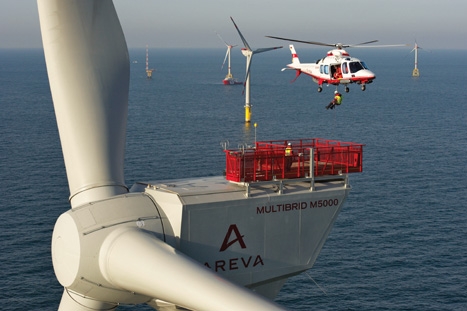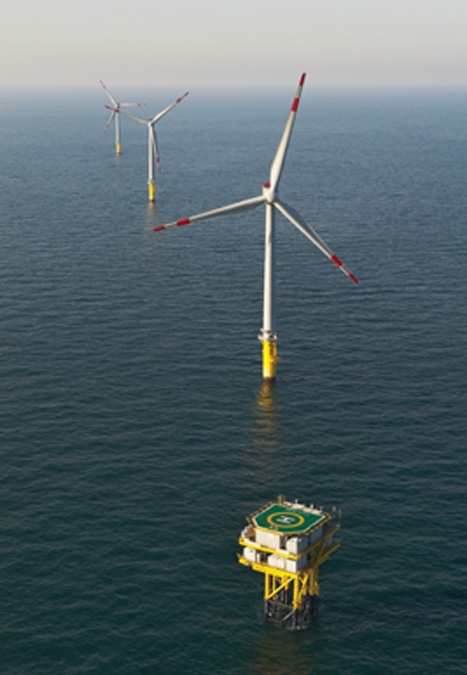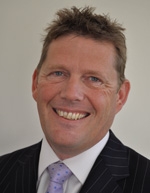Britain is the windiest country in Europe, as anyone who’s tried to stand upright in the Outer Hebrides will tell you. But even the fiercest winds that batter moor and mountain top pale into insignificance when compared with the gales off shore, in the North Sea and the Atlantic. This is why UK waters are seen as such a fruitful location for offshore wind farms, where the wind is stronger, often less gusty and blows more reliably than on shore. As yet, however, there are comparatively few.
Reversing this trend is a major concern for Julian Brown, who has become country director for UK wind at Areva, the French energy firm better known as the European supplier of reactors for the latest nuclear power stations. Areva’s wind energy business concentrates on offshore, with its main product, a 5MW geared turbine incorporating a low-speed generator, designed for the offshore environment.
Brown’s background is in the wind industry but for the past seven years he has been an independent contractor, advising companies on how best to enter the industry. ’I’ve spent a lot of time guiding businesses into wind and exploring how to develop a wind industry in the UK, learning from the industries in Germany, Denmark and Spain,’ he said. ’As the UK offshore industry started to develop, I decided I wasn’t happy with just consulting on the business; I wanted to get involved with it again. Areva had been a client of mine for some time and I’m impressed with its product and business approach; it would have been wrong for me not to get involved when the opportunity arose.’

Despite its potential as an offshore wind location, the UK is not yet geared up for the offshore wind business, Brown said. ’Engineering wise, the UK can do pretty much anything; the question is, can it do it cost effectively? Germany, Denmark and Spain are so far ahead in terms of volume of production.’ He stressed that helping UK companies become competent and competitive suppliers is key to his personal philosophy – and to Areva’s business strategy. ’Participating in UK projects means developing a supply chain and creating an industrialisation plan for the UK,’ he said. ’Offshore wind has to deliver two things: competitively priced energy and a real economic benefit to the communities it serves. It’s a passion for me that we should be able to combine the two.’ Brown wouldn’t say whether Areva plans to manufacture in the UK itself, but his priority is to establish a supply chain. Offshore wind has to operate in arduous conditions, he said, and that means performance has to be allied with robustness. ’It’s a very complex piece of kit. These machines are designed to operate 24/7 and only be visited twice a year. You have to maintain those levels of performance and reliability.’
This, he said, requires a particular combination of capabilities. ’You have to draw from the volume experience that the UK has in the automotive sector and combine that with the ability to make structures of the physical size that is close to what the oil and gas industry produces. Then you have to overlay that with the sort of reliability and performance that you expect from the aerospace industry.’
All of these exist in the UK, Brown admitted, but generally not in the same organisation. ’We haven’t delivered that magic combination of automotive mindset, oil and gas technology and aerospace performance on all fronts. There are some notable organisations that do understand what’s involved, but the job’s not done yet.’
“I think 10MW turbines will come, but they’re scary bits of kit. It’s not for the fainthearted to put something of that size on top of a tower 100m tall”
The job also isn’t done on the technology itself, Brown added. ’It’s evolving. The earliest offshore turbines were in the easiest places – shallow waters with small waves, less current and easy geology. But as wind farms get bigger, you need more area, so you have to go out to the areas that are more challenging, deeper and rougher.’ The problems that environment poses have not been solved yet – at least, not for this specific application. ’Oil and gas technology has proved it can operate in that setting and the wind industry is trying to learn from that, but bringing the cost down so that we don’t pay oil and gas prices.’
Foundations are a particular problem, with current solutions looking at concepts based on floating steel and concrete structures. But the turbines themselves are also evolving, with capacity a key concern. Large turbines, such as Areva’s 5MW unit, are attractive because fewer of them are needed to generate large amounts of electricity. ’The turbine is only 40 per cent of the cost,’ Brown said. ’Foundations and cables, which are related to the number of units rather than the generating capacity, are more of a cost driver.’

The 5MW turbines are now beginning to enter service – Areva’s have been installed at a site off the coast of Northern Germany. Brown believes there will now be a period of optimisation before the next jump in capacity. ’I think 10MW turbines will come, but they’re scary bits of kit. It’s not for the fainthearted to put something of that size and complexity on top of a tower 100m tall.’
The UK also isn’t ready in terms of the distribution system, Brown said. ’There needs to be grid renewal to handle the demands of offshore wind, and it’ll require government intervention. The industry is championing the integration of the grid across Northern Europe and that will mean a strengthening of the grid infrastructure. But energy demands are increasing anyway,’ he added, ’and we’ll need to strengthen the grid to meet those demands, whatever generation technology we use.’

julian brown
biography
Country director for UK wind at Areva
Career
1989 Materials manager at Renishaw
1994 Manufacturing director at Peek
1996 Managing director at software company IPE
1997 Managing director at Britax Aircraft Seating
2000 Managing director at NEG Micron Rotors, the largest employer in the UK wind energy sector, now part of Vestas
2004 Founded executive coaching company Excellence in Leadership and renewable energy consultancy Julian Brown Associates
2011 Joined Areva Multibrid in his current position
Q&A Defying the laws of physics
Does offshore wind avoid the controversy that causes problems for onshore wind?
Local communities might say that they don’t want a wind farm next to their town but they wouldn’t mind one off shore. But offshore isn’t an easy run. You’re putting big machinery into a physical environment that is expensive and challenging – deep water, big waves and tidal flows – so there’s a cost penalty.
There are far more planning and stakeholder issues than you might expect as well, with fisheries and the environmental impact, the shipping industries and the Ministry of Defence.
How do the costs of offshore wind stack up at the moment?
That is the question, whether you can build the farms and produce the electricity competitively. The wind industry has made huge strides towards grid parity – competing directly with fossil fuels – over the last 20 years. In general, onshore wind can compete with coal and gas, although you have to take into account whether you’re talking about lifetime costs and what penalty you’re putting on carbon dioxide. Nuclear is more contentious and offshore is slightly more expensive than nuclear. But it’s on a journey. It’s an immature technology and maturing fast.
What help is available from the government?
The government has said that it would support the further development of offshore wind on a large scale if the industry could demonstrate that it could generate electricity at a cost of £100/MWhr, which is pretty close to parity. The cost is currently said to be of the order of about £150/MWhr. I personally believe that the industry will hit the target and will get the government support.
Is Areva’s 5MW turbine in commercial use?
Yes; it’s already operational on the Alpha Ventus wind farm, which is in the German North Sea, and there were a number of prototypes in operation before that. We have a larger commercial wind farm currently being built, also in German waters.
How is turbine technology developing?
Each generation of turbines has defied the laws of physics – the cube rule says that as turbines get bigger, the weight goes up by the cube of their dimensions, and so the cost also goes up by the cube; but the surface area of the turbine blades, which drives energy capture, goes up by the square of the dimensions. So, in theory, they should get less efficient as they get bigger. However, the industry has consistently bucked that trend and made turbines that get more efficient as they get bigger; that’s why they’re viable at 5MW and above. As I said, there will be some optimisation at that scale before we move on to larger turbines and Areva’s latest development is a 135m turbine that increases the swept area by 35 per cent. That shows confidence in the product, because it’s increasing the power captured from the wind using the same turbine.




Nanogenerator consumes CO2 to generate electricity
Whoopee, they've solved how to keep a light on but not a lot else.